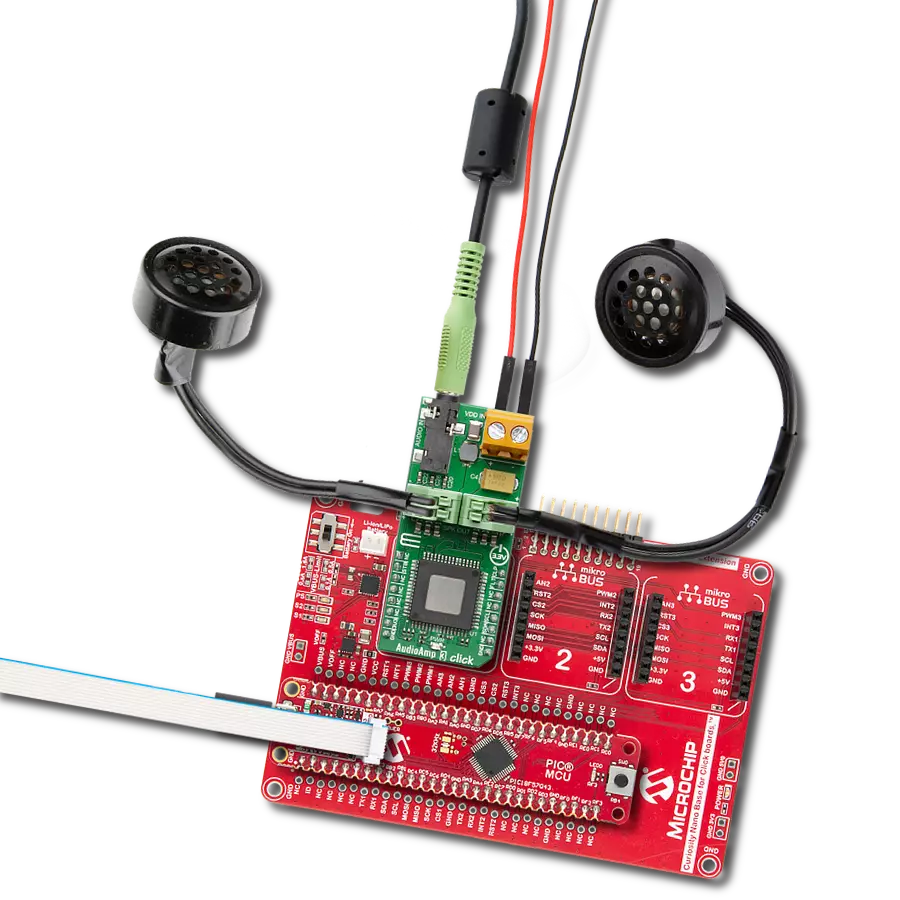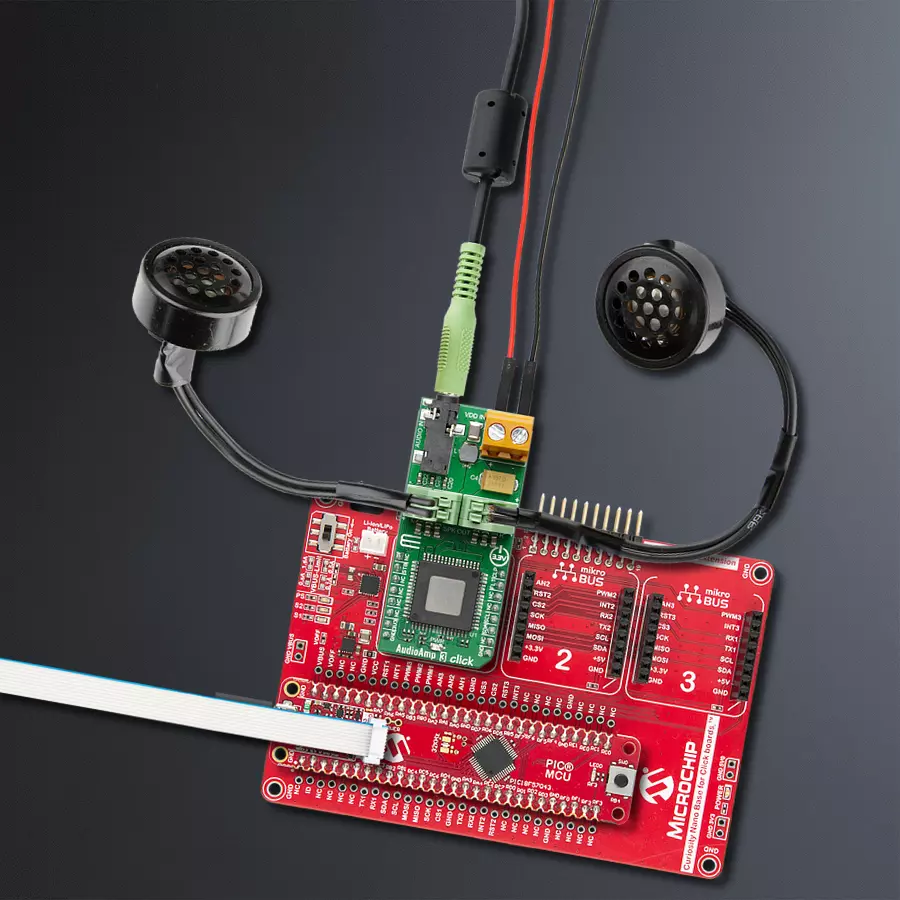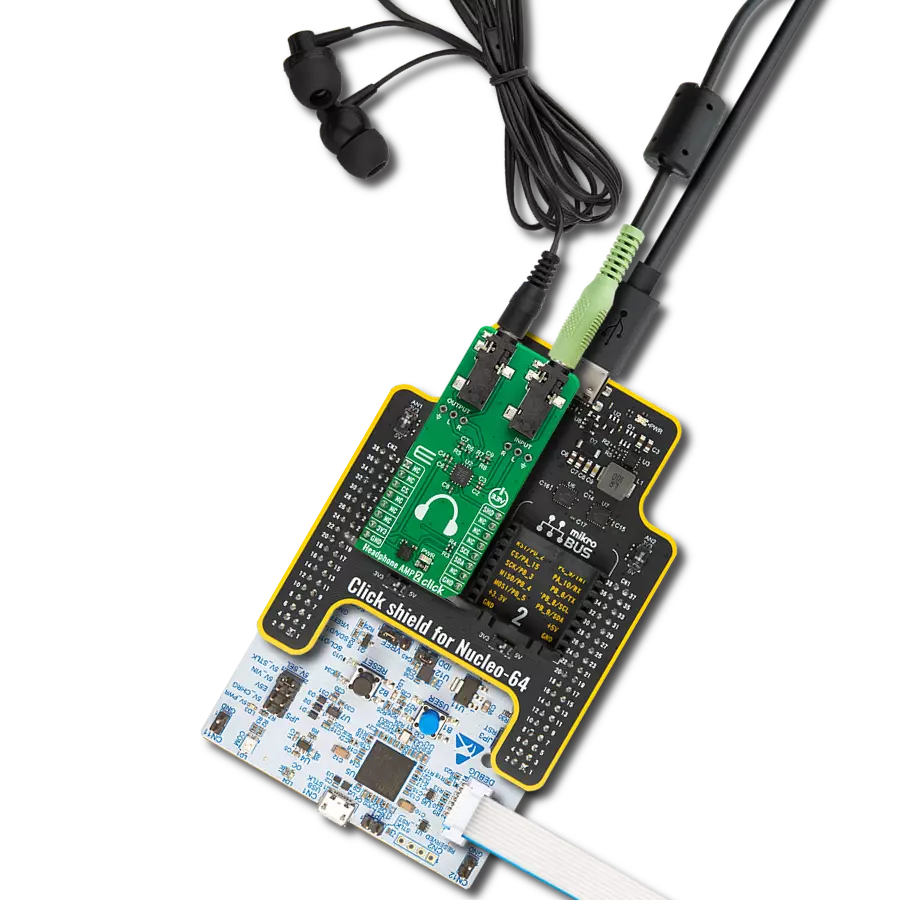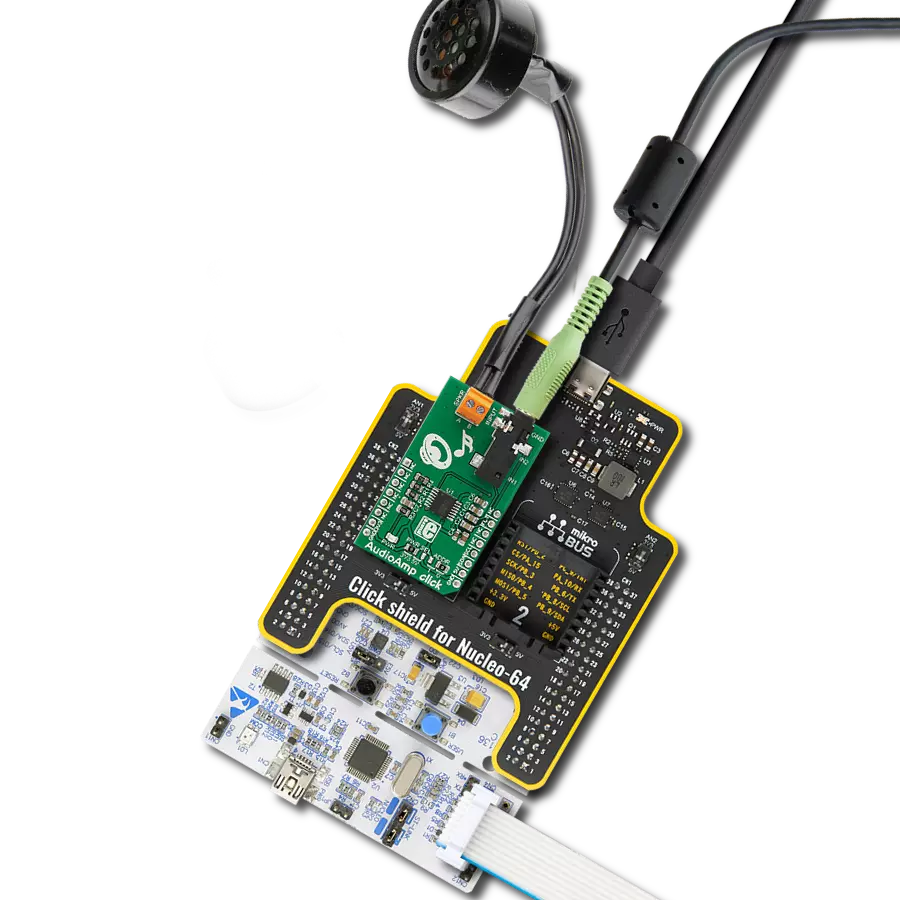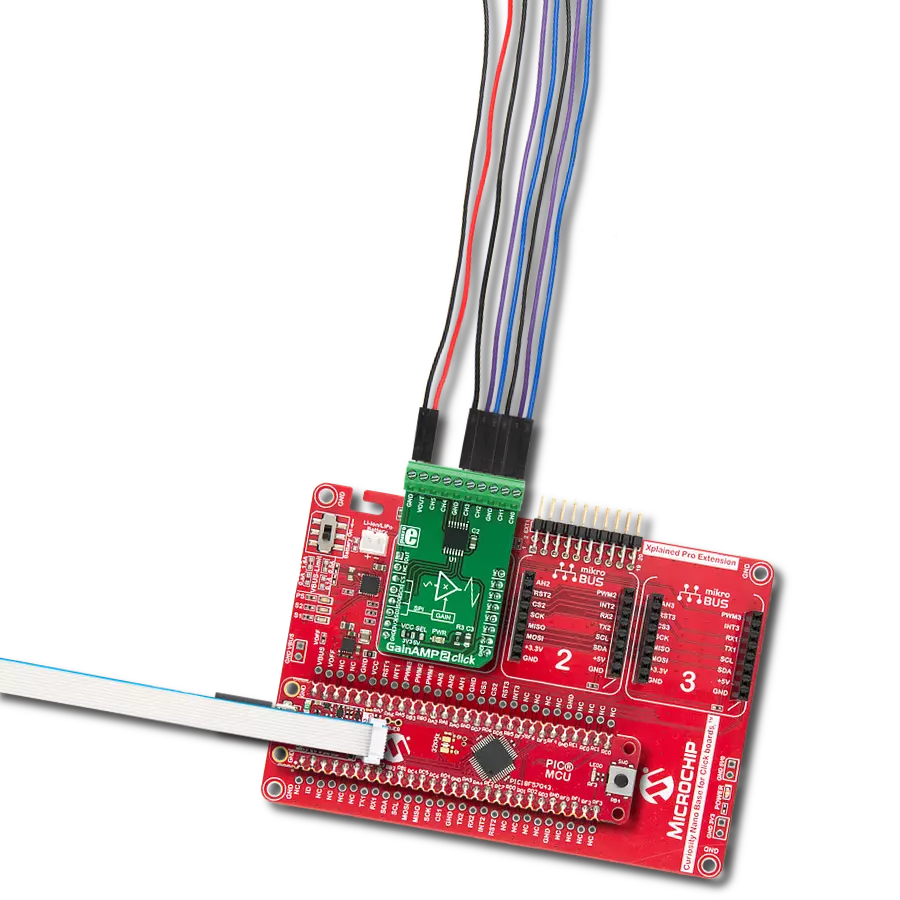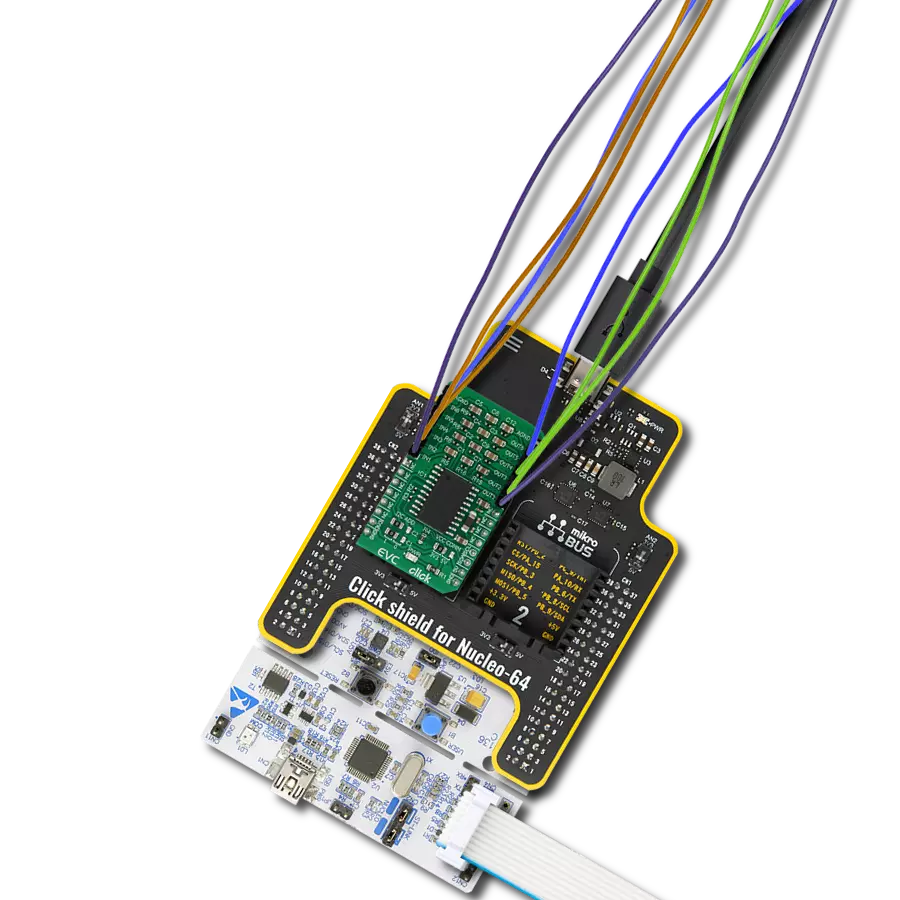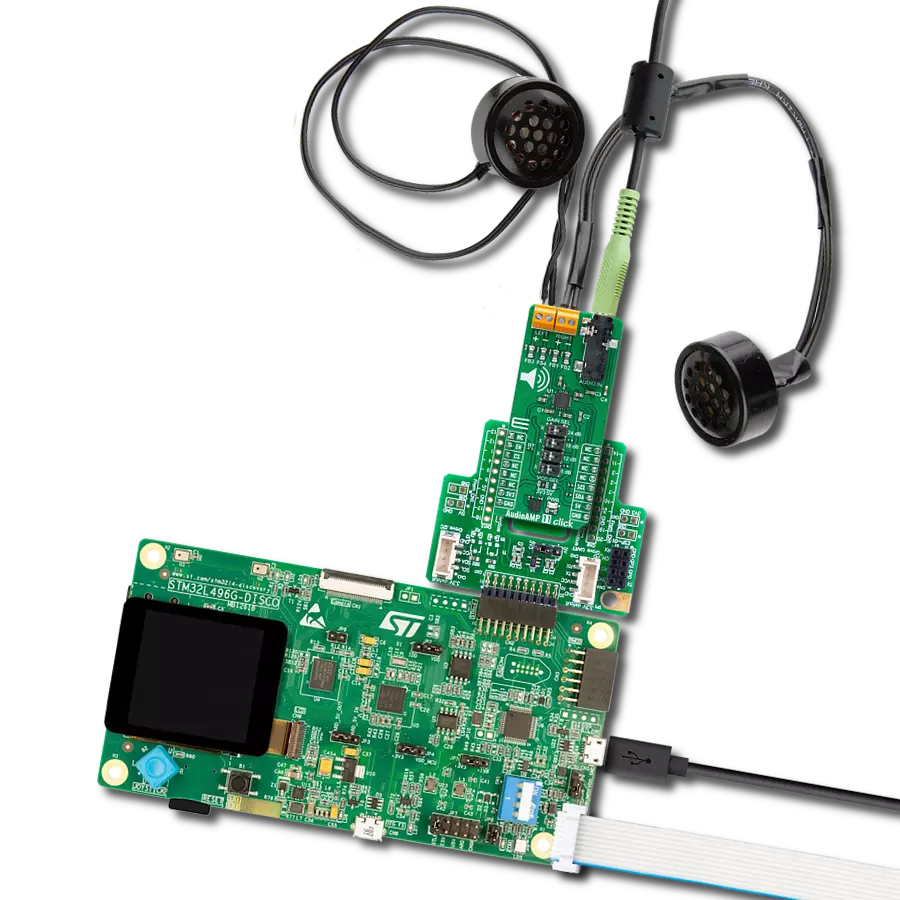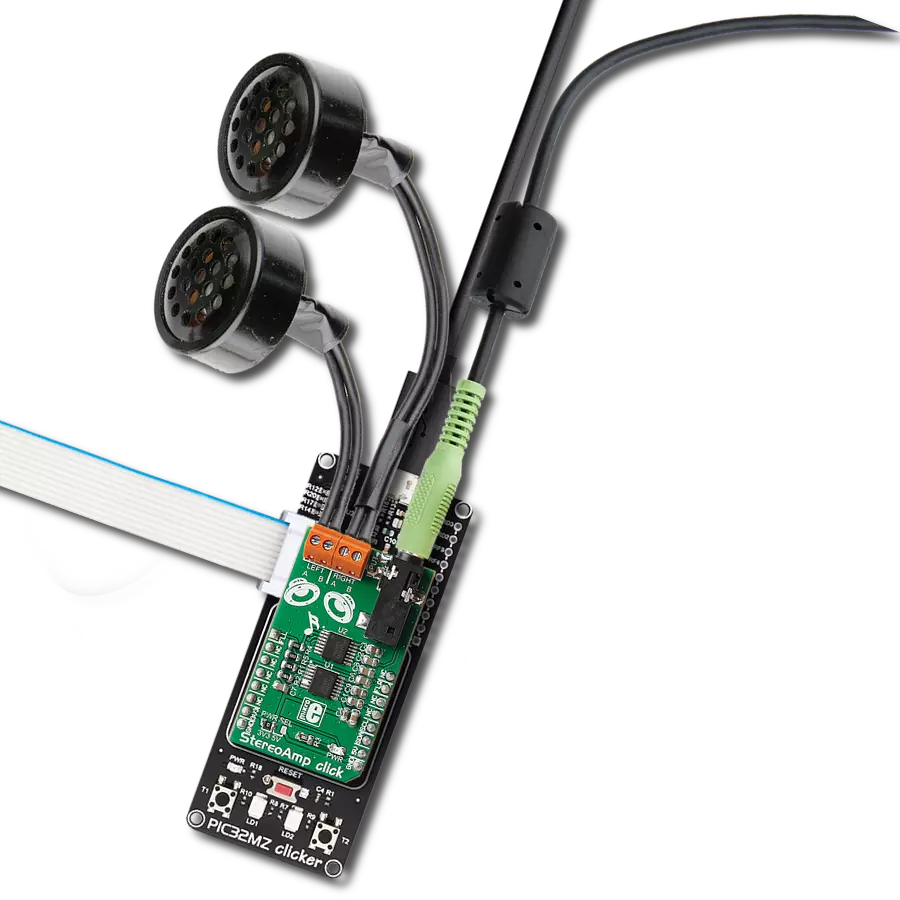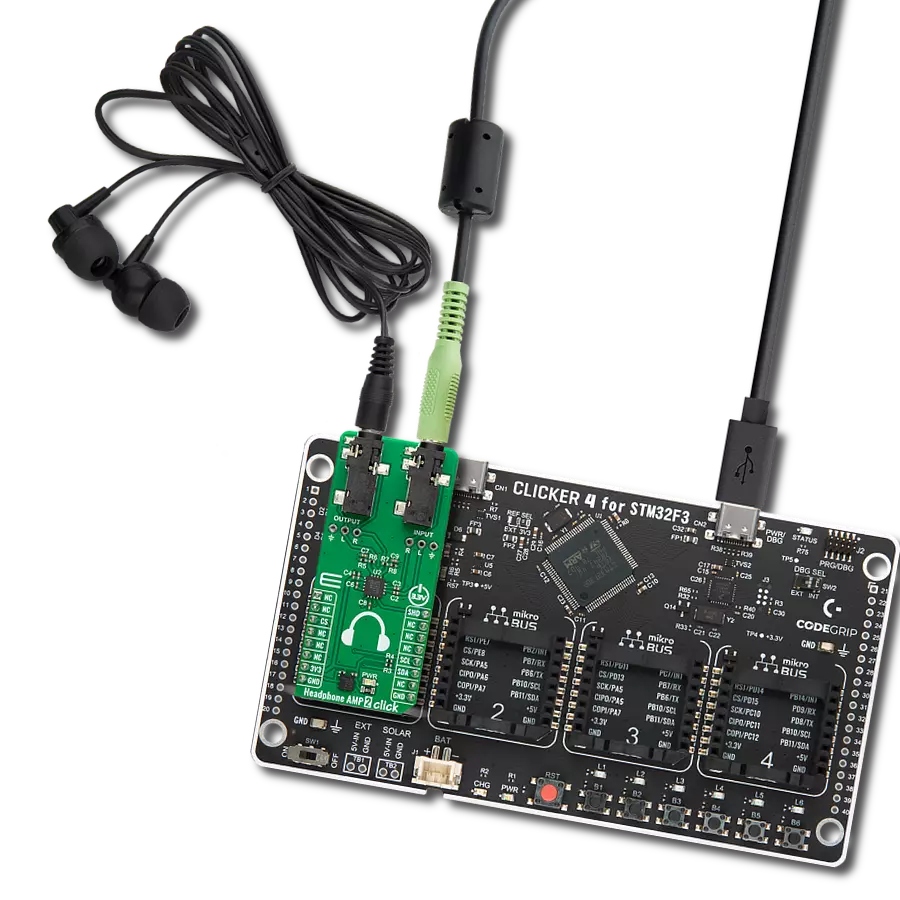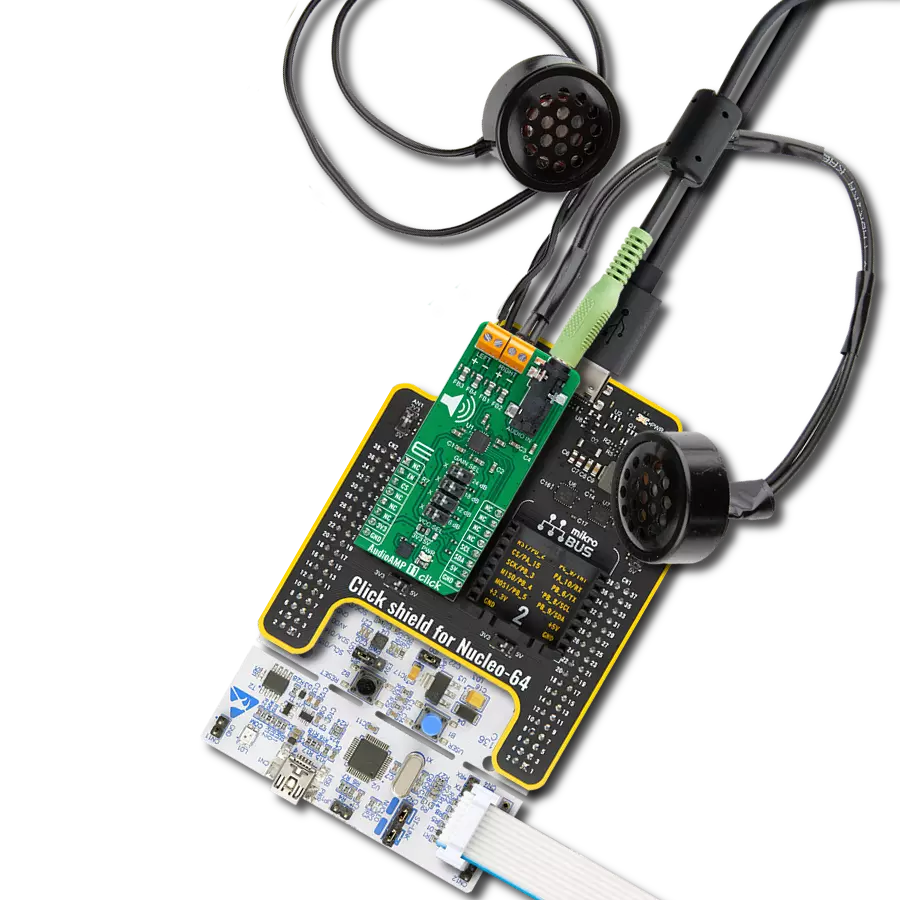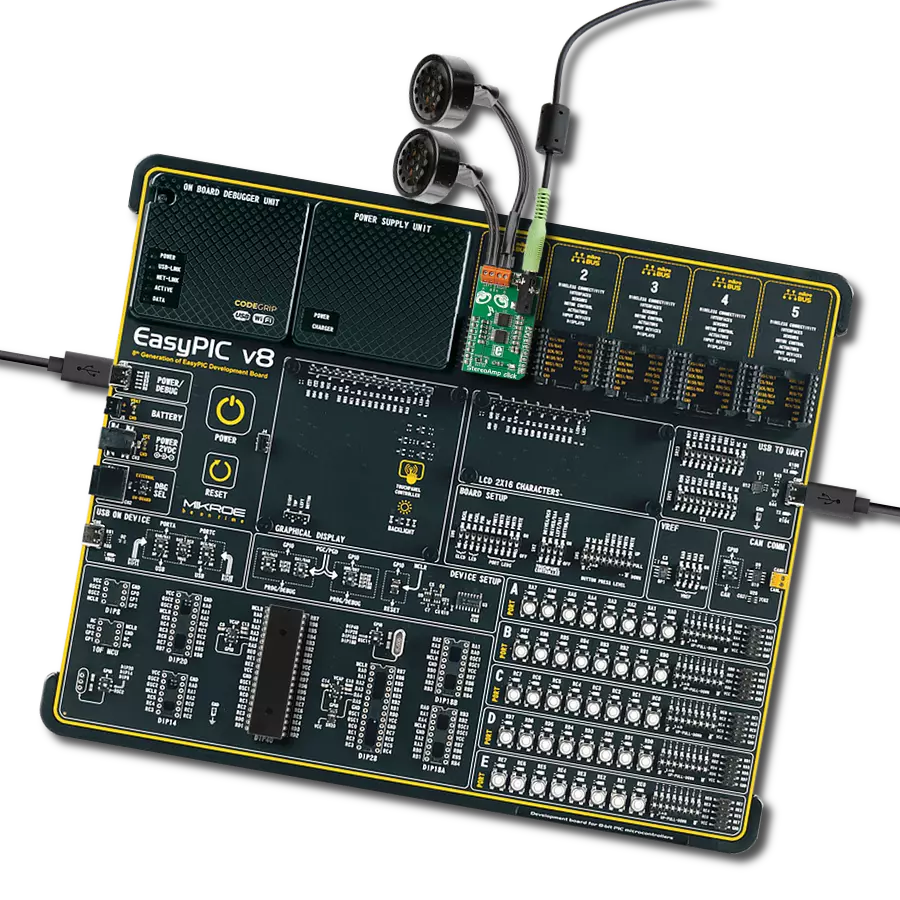Experience stereo brilliance and let our amplifier take your audio to new heights of clarity and depth
A
A
Hardware Overview
How does it work?
AudioAmp 3 Click is based on the TAS5414, an automotive stereo class-D audio amplifier from Texas Instruments. It has many features that make this IC a very attractive solution for stand-alone active speakers. It is very flexible regarding the PSU voltage: it can work with voltages within the range of 6V to 24V. Its nominal operating voltage used at the PSU connector (14.4V) can still deliver up to 28W of power per channel to 4Ω load. However, outputs can be paralleled (PBTL mode), reaching over 100W of power to the connected 2Ω speaker, with a low value of Total Harmonic Distortion (THD), at 24V power supply voltage. This Click board™ requires an external Power Supply Unit (PSU). It can use various power supply voltages, from 6V to 24V. AudioAmp 3 Click is a perfect solution for different kinds of active desktop speakers, battery-powered Bluetooth® and wireless speakers, TV sets and PC monitors, and other types of consumer audio equipment. Due to its high efficiency can even be used as a sound reinforcement solution for various IoT applications. The device communicates with the system processor via the I2C serial communication bus as an I2C slave-only device.
The processor can poll the device via I2C to determine the operating status. All fault conditions and detections are reported via I2C. Numerous features and operating conditions can also be set via I2C. The TAS5414 IC features a set of protections, including output short circuit, over-temperature, under-voltage, over-voltage protection, and more. These protections will be reported to the main MCU at the FLT pin if any of these are activated. The TAS5414 IC can also detect a constant DC current at the output. When a DC detection event occurs, the outputs are turned OFF, protecting the connected speakers. The output stage of the TAS5414 operates in Bridge-Tied Load (BTL) topology. This means there are two outputs per channel: inverted and non-inverted (OUTN and OUTP). Class-D amplifier produces the sound by modulating the pulse-with of the output voltage. While there is no input, OUTN and OUTP are in phase, with a 50% duty cycle. There is no current through the speaker in this case. The duty cycle will increase at the OUTP and decrease at the OUTN simultaneously when the positive half-phase of the audio signal is applied at the input. For the negative half-phase at the input, the opposite will happen.
The greater the difference in pulse width, the greater the current through the connected speaker. Muting the TAS5414 before cutting down the power supply reduces the pops and clicks that might appear. The FLT pin is routed to the mikroBUS™ CS pin labeled as INT on this Click board™ and pulled to a HIGH logic level by a resistor. The external PSU should be connected to the VIN terminal. A line-level audio source can be connected to the LINE IN 3.5mm jack stereo connector, while the speakers should be connected to the angled spring terminals labeled OUTL and OUTR. These terminals have their polarities marked on the top overlay. Although the TAS5414 requires an external PSU, this Click board™ can only be operated with a 3.3V logic voltage level. The board must perform appropriate logic voltage level conversion before using MCUs with different logic levels. However, the Click board™ comes equipped with a library containing functions and an example code that can be used as a reference for further development.
Features overview
Development board
PIC18F57Q43 Curiosity Nano evaluation kit is a cutting-edge hardware platform designed to evaluate microcontrollers within the PIC18-Q43 family. Central to its design is the inclusion of the powerful PIC18F57Q43 microcontroller (MCU), offering advanced functionalities and robust performance. Key features of this evaluation kit include a yellow user LED and a responsive
mechanical user switch, providing seamless interaction and testing. The provision for a 32.768kHz crystal footprint ensures precision timing capabilities. With an onboard debugger boasting a green power and status LED, programming and debugging become intuitive and efficient. Further enhancing its utility is the Virtual serial port (CDC) and a debug GPIO channel (DGI
GPIO), offering extensive connectivity options. Powered via USB, this kit boasts an adjustable target voltage feature facilitated by the MIC5353 LDO regulator, ensuring stable operation with an output voltage ranging from 1.8V to 5.1V, with a maximum output current of 500mA, subject to ambient temperature and voltage constraints.
Microcontroller Overview
MCU Card / MCU

Architecture
PIC
MCU Memory (KB)
128
Silicon Vendor
Microchip
Pin count
48
RAM (Bytes)
8196
You complete me!
Accessories
Curiosity Nano Base for Click boards is a versatile hardware extension platform created to streamline the integration between Curiosity Nano kits and extension boards, tailored explicitly for the mikroBUS™-standardized Click boards and Xplained Pro extension boards. This innovative base board (shield) offers seamless connectivity and expansion possibilities, simplifying experimentation and development. Key features include USB power compatibility from the Curiosity Nano kit, alongside an alternative external power input option for enhanced flexibility. The onboard Li-Ion/LiPo charger and management circuit ensure smooth operation for battery-powered applications, simplifying usage and management. Moreover, the base incorporates a fixed 3.3V PSU dedicated to target and mikroBUS™ power rails, alongside a fixed 5.0V boost converter catering to 5V power rails of mikroBUS™ sockets, providing stable power delivery for various connected devices.
Used MCU Pins
mikroBUS™ mapper
Take a closer look
Click board™ Schematic

Step by step
Project assembly
Software Support
Library Description
This library contains API for AudioAmp 3 Click driver.
Key functions:
void audioamp3_cfg_setup ( audioamp3_cfg_t *cfg )- This function power up the audio amplifierAUDIOAMP3_STATUS_T audioamp3_set_play_mode ( audioamp3_t *ctx )- This function set the play mode for all channelsAUDIOAMP3_STATUS_T audioamp3_set_gain_lvl ( audioamp3_t *ctx, uint8_t gain_lvl )- This function set the gain level for all channels
Open Source
Code example
The complete application code and a ready-to-use project are available through the NECTO Studio Package Manager for direct installation in the NECTO Studio. The application code can also be found on the MIKROE GitHub account.
/*!
* \file
* \brief AudioAmp3 Click example
*
* # Description
* AudioAmp 3 Click is a stereo audio amplifier, capable of delivering
* up to 79W per channel with the 4Ω load.
*
* The demo application is composed of two sections :
*
* ## Application Init
* Application Init performs Logger and Click initialization.
*
* ## Application Task
* This is an example which demonstrates the use of AudioAmp 3 Click board.
* In application task function is used that will increase volume of the sound
* from MIN to MAX and reverse.
* Results are being sent to the UART Terminal where you can track their changes.
*
* \author Mihajlo Djordjevic
*
*/
// ------------------------------------------------------------------- INCLUDES
#include "board.h"
#include "log.h"
#include "audioamp3.h"
uint8_t cnt;
uint8_t data_out[ 10 ];
uint8_t status_flag;
// ------------------------------------------------------------------ VARIABLES
static audioamp3_t audioamp3;
static log_t logger;
// ------------------------------------------------------ APPLICATION FUNCTIONS
void application_init ( void )
{
log_cfg_t log_cfg;
audioamp3_cfg_t cfg;
/**
* Logger initialization.
* Default baud rate: 115200
* Default log level: LOG_LEVEL_DEBUG
* @note If USB_UART_RX and USB_UART_TX
* are defined as HAL_PIN_NC, you will
* need to define them manually for log to work.
* See @b LOG_MAP_USB_UART macro definition for detailed explanation.
*/
LOG_MAP_USB_UART( log_cfg );
log_init( &logger, &log_cfg );
log_info( &logger, "---- Application Init ----" );
Delay_ms ( 100 );
// Click initialization.
audioamp3_cfg_setup( &cfg );
AUDIOAMP3_MAP_MIKROBUS( cfg, MIKROBUS_1 );
audioamp3_init( &audioamp3, &cfg );
log_printf( &logger, "--------------------------\r\n\n" );
log_printf( &logger, "--- AudioAmp 3 Click ---\r\n" );
log_printf( &logger, "--------------------------\r\n\n" );
Delay_ms ( 1000 );
audioamp3_power_up( &audioamp3 );
log_printf( &logger, " Power Up \r\n" );
log_printf( &logger, " ---------------------------\r\n\n" );
Delay_100ms();
audioamp3_set_channel_low_to_low( &audioamp3, AUDIOAMP3_MASK_BIT_SEL_CH_1 );
log_printf( &logger, " Set channel 1 low-low state \r\n" );
log_printf( &logger, " ---------------------------\r\n\n" );
Delay_100ms();
audioamp3_set_channel_low_to_low( &audioamp3, AUDIOAMP3_MASK_BIT_SEL_CH_2 );
log_printf( &logger, " Set channel 2 low-low state \r\n" );
log_printf( &logger, " ---------------------------\r\n\n" );
Delay_100ms();
audioamp3_set_channel_mute_mode( &audioamp3, AUDIOAMP3_MASK_BIT_SEL_ALL_CH );
log_printf( &logger, " Mute All Channels \r\n" );
log_printf( &logger, " ---------------------------\r\n\n" );
Delay_100ms();
audioamp3_run_channel_diagnostics( &audioamp3, AUDIOAMP3_MASK_BIT_SEL_ALL_CH );
log_printf( &logger, " Run Diagnostics \r\n" );
log_printf( &logger, " ---------------------------\r\n\n" );
Delay_100ms();
audioamp3_hw_reset( &audioamp3 );
log_printf( &logger, " Hardware Reset \r\n" );
log_printf( &logger, " ---------------------------\r\n\n" );
Delay_100ms();
audioamp3_read_all_diagnostics( &audioamp3, &data_out[ 0 ] );
log_printf( &logger, " Read Diagnostics \r\n" );
log_printf( &logger, " ---------------------------\r\n\n" );
Delay_100ms();
log_printf( &logger, "--------------------------\r\n\n" );
log_printf( &logger, " Initialization done \r\n" );
log_printf( &logger, "--------------------------\r\n\n" );
Delay_ms ( 1000 );
audioamp3_set_play_mode( &audioamp3 );
log_printf( &logger, " ---------------------------\r\n\n" );
log_printf( &logger, " Play \r\n" );
log_printf( &logger, " ---------------------------\r\n\n" );
Delay_100ms();
}
void application_task ( void )
{
for ( cnt = AUDIOAMP3_GAIN_VAL_MIN; cnt < AUDIOAMP3_GAIN_VAL_5; cnt++ )
{
status_flag = audioamp3_set_gain_lvl( &audioamp3, cnt );
log_printf( &logger, " - Volume Up - \r\n" );
Delay_ms ( 1000 );
Delay_ms ( 1000 );
}
log_printf( &logger, " ---------------------------\r\n\n" );
for ( cnt = AUDIOAMP3_GAIN_VAL_MAX; cnt > AUDIOAMP3_GAIN_VAL_0; cnt-- )
{
status_flag = audioamp3_set_gain_lvl( &audioamp3, cnt );
log_printf( &logger, " - Volume Down - \r\n" );
Delay_ms ( 1000 );
Delay_ms ( 1000 );
}
log_printf( &logger, " ---------------------------\r\n\n" );
}
int main ( void )
{
/* Do not remove this line or clock might not be set correctly. */
#ifdef PREINIT_SUPPORTED
preinit();
#endif
application_init( );
for ( ; ; )
{
application_task( );
}
return 0;
}
// ------------------------------------------------------------------------ END
Additional Support
Resources
Category:Amplifier
